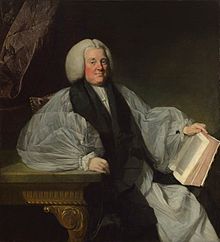Edmund Keene | |
|---|---|
| Bishop of Ely | |
 Bishop Keene, by Johan Zoffany, 1768 | |
| Diocese | Diocese of Ely |
| In office | 22 January 1771 – 6 July 1781 (death) |
| Predecessor | Matthias Mawson |
| Successor | James Yorke |
| Other post(s) | Bishop of Chester (1752–1771) Vice-chancellor, University of Cambridge (1749–1750) |
| Personal details | |
| Born | 1714 |
| Died | 6 July 1781 (aged 67) Ely Place, London |
| Buried | Bishop West's Chapel, Ely Cathedral |
| Nationality | British |
| Denomination | Church of England |
| Residence | Ely Palace, London |
| Parents | Charles Keene (1674–?) Susan Rolfe (? – 1753) |
| Spouse | Mary Andrewes (1725–1776) |
| Children | Benjamin Keene (1753–1837) |
| Profession | Clergy |
| Education | Charterhouse |
| Alma mater | Gonville and Caius College, Cambridge |
Edmund Keene (1714 – 6 July 1781) was an English churchman and academic, who was Master of Peterhouse, Cambridge and later served first as Bishop of Chester, then Bishop of Ely.
Younger brother of the diplomat Benjamin Keene, the family were close friends of Sir Robert Walpole, British Prime Minister from 1721 to 1742. This connection helped him secure a series of lucrative positions in his early career but it was his relationship with Walpole's successor Thomas Pelham-Holles, 1st Duke of Newcastle that proved most beneficial.
With Newcastle's support, he was appointed Vice-chancellor of the University of Cambridge in 1749, carrying out a number of reforms. In 1752, he became Bishop of Chester, then Bishop of Ely in 1771, his 'great object, the aim and end of his ambition'.[1]